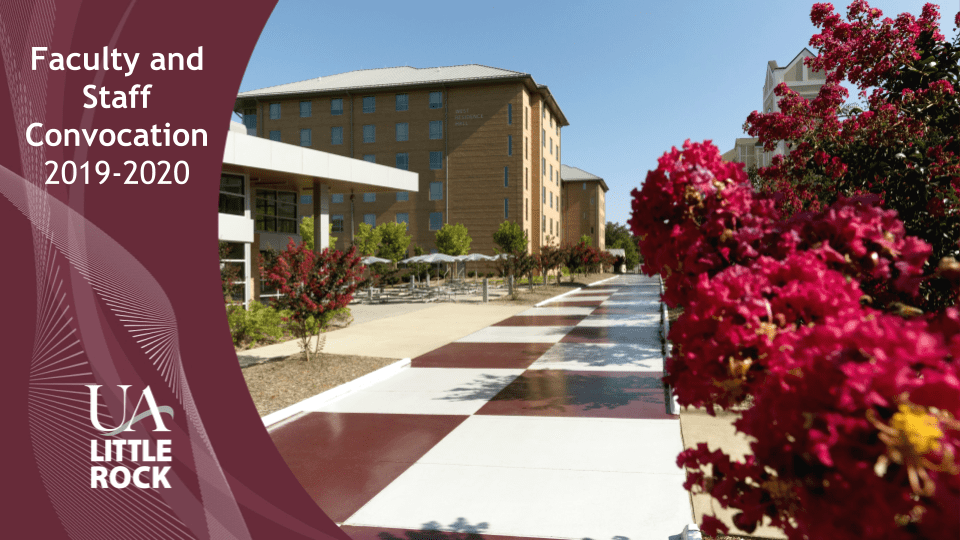Faculty and Staff Convocation Remarks
Good afternoon and welcome; it is a pleasure to come together with faculty and staff to celebrate the beginning of a new academic year. In a moment I will be introducing our new faculty to all of you, but in the spirit of celebration, I want to start with a few thoughts that I think represent the best aspects of who we are as a university.
Several weeks ago I held a deans council retreat. We had a lot of tough topics to wrestle with, but before we got started on those, I wanted the group first to think about our identity as an institution. Who are we? I asked them to set aside our formal mission statement for the moment; to clear their minds of official statements and try to identify what they believed our essential characteristics really are. What makes us who we are? How do we serve our community, our region, our students?
As we brainstormed on these essential characteristics, the terms that came forth were pretty consistent. There were some familiar terms that you might expect: metropolitan university, R-2 institution, research-engaged faculty, and community-engaged. But there were also these terms: ladder of opportunity, intervention, faculty as mentors, building cultural and social capital, growth-focused, and transformational.
The identity that emerged from that discussion describes an institution that recognizes that as we strive for distinction in our research profile, our public service, and our educational programs, we also understand the life-changing responsibility that we hold for our students and our community. And I believe we take that responsibility very seriously. All of us, faculty and staff, have a role to play in nurturing the transformation of our students. Whether you’re the administrative assistant that helps a student find her way, or the faculty member that participates in a learning community, or the IT employee that helps maintain a dynamic learning environment—all of us recognize that our students are counting on us to help them grow and reach their potential.
UA Little Rock, like all universities, is facing new challenges in the form of changing demographics, changing public expectations, and changing market conditions. But I believe that another essential characteristic of this university is that we have come to recognize that in the face of increasing competition, our best strategy is collaboration. I’ve had the privilege of serving with faculty and staff in some amazing groups. The steering team and committees of our HLC accreditation initiative have been phenomenal in not only preparing materials for the accreditation visit but in making sure that the infrastructure that we were missing gets filled in as much as possible. This group has created a policy review board, a consumer information web site, a student complaint hotline, a comprehensive assessment plan, to name just a few; and the massive effort of our quality initiative group has created the Decision Support System that among other things has made possible the Trojan Fact dashboards that allow you to search for critical information down to the individual program level and by specific student populations.
There are many other examples I could give—the groups and individuals that collaborate to run the Signature Experience Awards and the Research Expo is a magnificent example of collaboration—lots of moving parts and a huge number of people come together to pull this off. The Institutional Effectiveness Committee, which has a very challenging set of tasks, has demonstrated a truly impressive capacity to overcome territorial boundaries and work towards a common purpose. We have assembled several committees dedicated to the recruitment and retention of our students. Faculty, staff, and administrators brainstorm together to find ways to remove barriers and facilitate positive change.
And it isn’t all big things either. Those of you who were following Facfocus this summer saw a touching example of the campus community rallying to save a butterfly bush that was planted 11 years ago by a group of students as a class project to honor sexual assault victims. In case you missed it, the bush was mistakenly removed and thrown into a construction dumpster. The original message inquiring as to the whereabouts of the bush was posted on a Thursday evening. Throughout the next morning, people were on it. First, someone located where it was, then someone else took cuttings to save and regrow the bush, then another person flagged down a maintenance worker to help him dislodge the bush and get it out of the dumpster, then people wrote in with suggestions for caretaking. It was a beautiful thing—the students’ butterfly bush was saved. This is who we are.
So, as we welcome the new members of our campus community, as we celebrate the beginning of a new year, and contemplate our challenges ahead, remember that we have the capacity to do amazing things. And we will.
Dr. Christina Drale | Interim Executive Vice Chancellor and Provost
Now it is my pleasure to introduce our new faculty members.
View the New Faculty Presentation

